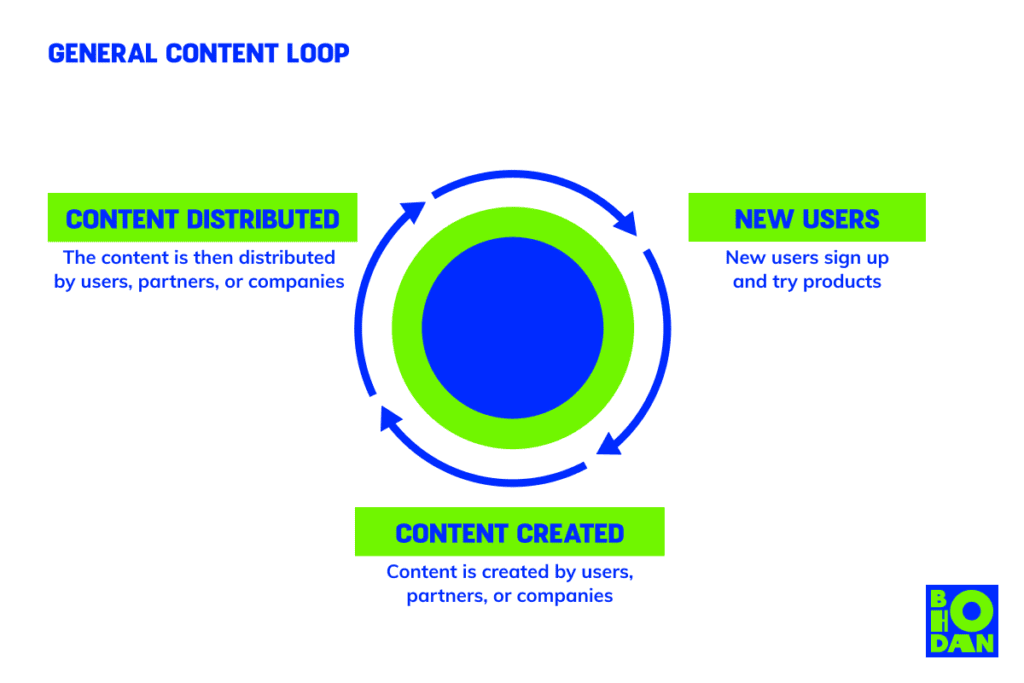The Rise of Content Loops in Growth Marketing

Growth marketing has become one of the few bright spots in marketing of 2024. It’s a rapidly growing discipline: Companies that are otherwise shedding jobs are doubling down on go-to-market and growth. Content distribution is increasingly competitive—it takes much more effort to find the right marketing channels to get eyeballs on your content. Among the innovative growth strategies that are gaining recognition are content loops. Unlike traditional linear marketing approaches, content loops create a self-sustaining cycle that continuously drives user engagement and growth. Moving away from the funnel-led marketing approach, which is no longer sustainable (since it requires more and more people at the top) growth marketing strategies such as content loops help you make the most out of the users you do have.
Understanding content loops
A content loop is a growth marketing strategy that prioritizes user engagement and content creation. Loops feed into each other, creating a cycle that perpetually drives traffic and interaction. Unlike traditional marketing funnels, which typically follow a linear path from awareness to conversion, content loops are cyclical. This continuous cycle helps retain users, generate organic growth, and build a loyal community.
Content loops hinge on the idea that every user interaction should add value and create opportunities for further engagement. These interactions can be in the form of user-generated content, social shares, feedback, or even new content inspired by user behavior. The key components of a content loop include:
- Engaging content creation: Producing high-quality content that attracts and retains users.
- User interaction: Encouraging users to engage with the content.
- Content amplification: Leveraging user interactions to reach a wider audience.
- Feedback integration: Incorporating user feedback to refine and create more engaging content.

Image courtesy of Bohdan Drozdov (2022)
The importance of content loops in growth marketing
The rise of content loops in growth marketing is driven by several factors:
- Increased user retention: By continuously engaging users, content loops help build a loyal customer base.
- Scalability: As user interactions drive more content creation and sharing, the strategy scales organically.
- Cost-effectiveness: Leveraging user-generated content and social sharing reduces the need for extensive paid advertising, although content marketing itself can be costly and time consuming.
- Enhanced brand loyalty: Consistent interaction and value addition foster a strong connection between the brand and its users.
Implementing content loops in your strategy
Implementing content loops requires a strategic approach tailored to your business model and audience. Here’s a step-by-step guide to creating effective content loops:
- Identify core content themes: Focus on topics that resonate deeply with your audience. Understanding your audience‘s pain points, interests, and preferences is crucial.
- Create high-quality, shareable content: Develop content that is valuable and shareable. This could be blog posts, videos, infographics, or social media posts.
- Encourage user interaction: Use calls-to-action (CTAs) to prompt users to engage with your content. This could include commenting, sharing, or creating their own content based on your material.
- Leverage social proof: Showcase user-generated feedback to build trust and encourage more users to participate.
- Analyze and optimize: Continuously monitor user interactions and feedback. Use this data to refine your content strategy and improve engagement.
- Promote user-generated content: Highlighting content created by users not only boosts engagement, but also encourages others to contribute.
HubSpot’s successful content loop strategy
HubSpot, a leader in inbound marketing, is an amazing example of effective use of content loops. Here’s how HubSpot has harnessed the power of content loops to fuel its growth:
- Educational content creation: HubSpot’s blog, academy, and resources center are packed with high-quality, educational content that addresses the pain points of marketers, salespeople, and customer service professionals. This valuable content attracts a steady stream of visitors seeking knowledge and solutions.
- User interaction and feedback: HubSpot encourages users to interact with their content through comments, social media sharing, and direct feedback. The HubSpot Community and user forums provide platforms for users to ask questions, share experiences, and offer suggestions.
- Amplifying content through social proof: HubSpot frequently showcases success stories, case studies, and testimonials from its users. This serves as social proof, while also inspiring other users to engage and share their success stories.
- Continuous content improvement: By analyzing user interactions and feedback, HubSpot continually refines its content strategy. They use insights from their audience to produce more targeted and effective content.
- Promoting user-generated content: HubSpot often highlights user-generated content, such as blog posts written by industry experts and practitioners who use their platform. This approach provides valuable content to their audience, and also fosters a sense of community and collaboration.
- Creating a self-sustaining loop: The combination of high-quality content, user engagement, social proof, and continuous improvement creates a self-sustaining content loop. As users engage with and share HubSpot’s content, it attracts new users, who then contribute to the cycle.
By creating valuable content and encouraging user engagement, companies like yours can build self-sustaining cycles that drive organic growth and foster brand loyalty. HubSpot’s success story illustrates the power of content loops in building a robust and engaged community.
For companies looking to implement content loops, it’s key to understand your audience, create shareable content, encourage interactions, and continuously refine your strategy based on user feedback. By doing so, you can create a content loop that not only scales your growth efforts, but also strengthens your brand’s relationship with its users.
Reach Out
Be Social
Content Marketing
Next In AI
Use AI to Inspire Your Writing: 7 Tips to Spark Creativity
Explore 7 tips to fuel your writing with AI, from sparking creativity to enhancing your style with Eve Connell's expert...


